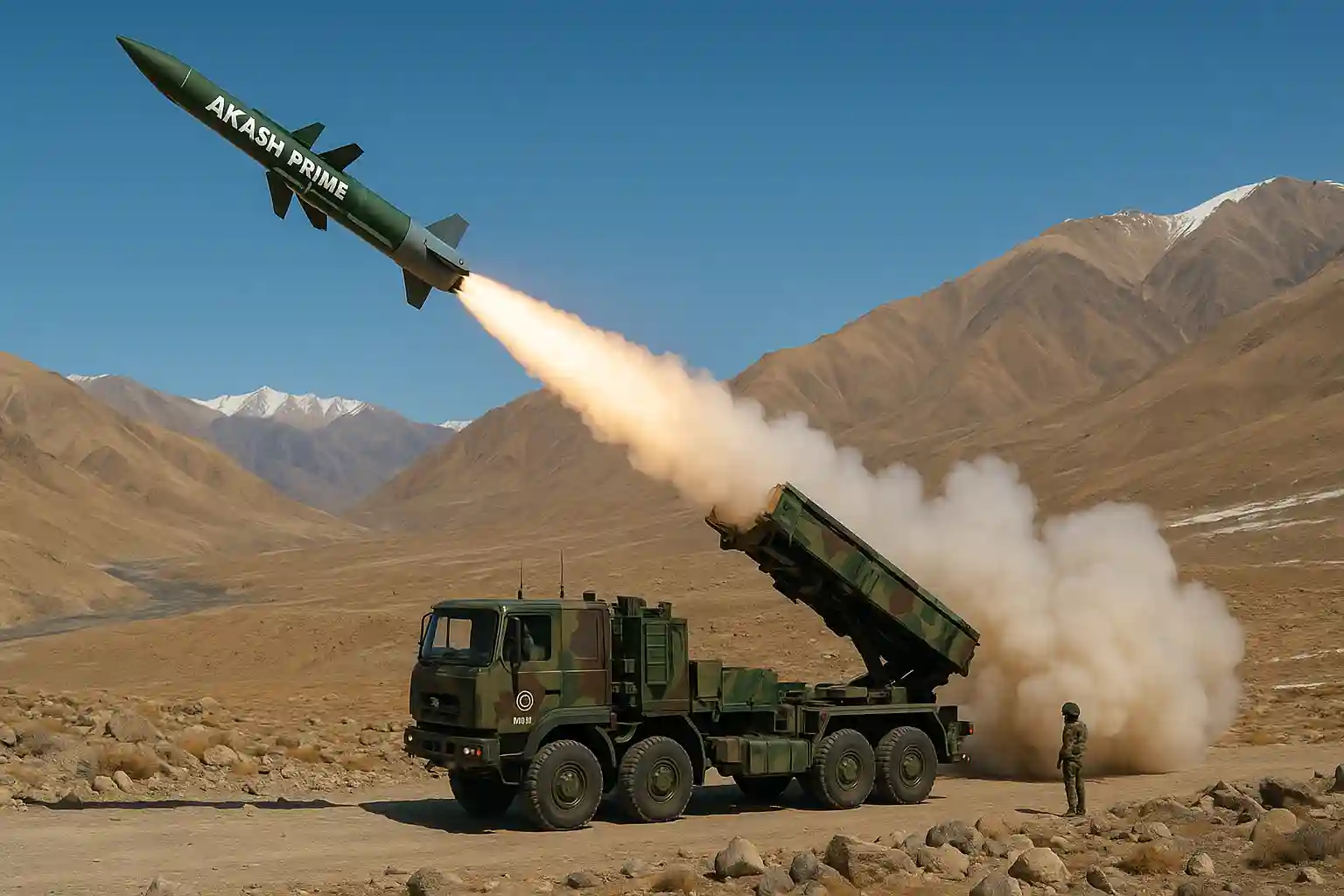Defending a nation at 15,000 feet is no ordinary task. At such altitudes, oxygen is scarce, temperatures plunge, and adversaries watch every move. Imported systems often falter here, but India needed a shield built for its own mountains. That answer is the Akash-Prime Air Defence System, developed by DRDO under the Atmanirbhar Bharat mission.
More than just a missile, it is a symbol of India’s self-reliance, battle-tested, cost-effective, and designed for Himalayan warfare. With successful Ladakh trials in July 2025 and induction into the Indian Army, Akash-Prime proves India can defend its skies with indigenous innovation.
The Spark: Operation Sindoor and the Need for Akash-Prime
The push for Akash-Prime accelerated after Operation Sindoor, a tense 12-day Indo-Pak flare-up in May 2025. Pakistan fired volleys of Fatah-I and Fatah-II guided rockets, aiming to overwhelm India’s defences. But India’s older Akash SAMs proved their worth; guided by Rajendra radars, they neutralised incoming rockets with near-perfect accuracy.
A senior Army officer described it as a “game-changer,” noting that indigenous interceptors saved both lives and assets. This battlefield success set the stage for the Army to embrace Akash-Prime, the evolutionary leap of the Akash family.
The Birth of Akash-Prime: How India Built Its Own Shield

The journey of Akash began in the 1990s, when India was heavily dependent on imports. Visionaries like Dr APJ Abdul Kalam and Dr Prahlada Ramarao planted the seeds of self-reliance. After decades of trials, learning, and refinements, DRDO unveiled Akash-Prime—a variant designed to dominate high-altitude environments where foreign systems hesitate.
Today, Akash-Prime stands as proof of India’s technological maturity: a system crafted to protect our skies at a fraction of the cost of Western imports, yet optimised for our unique battlefields.
Akash-Prime vs Other Air Defence Systems
Having tracked global missile systems, I can say confidently that Akash-Prime is different because it is designed specifically for India’s battlefronts. Western imports work well in general terrains. But India needs a solution for thin air, freezing temperatures, and Himalayan heights. That’s exactly where Akash-Prime excels.
It is not just a missile; it is a customised shield, optimised for India’s geography, and delivered at a fraction of the cost of Western systems.
Key Features and Akash-Prime Missile Specifications
- Akashteer Integration: Provides 360° networked coverage with the Army’s air defence grid.
- High-Altitude Capability: Tested at 14,000–15,000 ft in Ladakh, fully operational in low-oxygen and sub-zero temperatures.
- Indigenous RF Seeker: Home-grown seeker for precise terminal lock-on.
- Supersonic Interception: Neutralises targets at Mach 3–3.5.
- Extended Envelope: Range of 40–50 km, with altitude engagement up to 18 km.
- All-Weather Operation: Functional in rain, snow, fog, and dust.
- Advanced ECCM: Indigenous counter-countermeasure technology resists jamming.
These enhancements elevate the Akash-Prime Air Defence System beyond just a missile. They transform it into a comprehensive and reliable defence shield for India’s sensitive borders.
Akash-Prime Trials in Ladakh: A Clear Display of Strength
On 16 July 2025, the Indian Army conducted high-altitude trials of Akash-Prime at 14,000 feet in Ladakh.
- The system simulated Chinese J-20 stealth fighter incursions.
- It neutralised low-flying cruise missiles and drone swarms.
- Trials confirmed seamless integration with Akashteer command networks.
This wasn’t just a test. It was a demonstration that Akash-Prime can protect India’s most vulnerable high-altitude sectors.
Akash-Prime vs Western SAM Systems: India’s ₹5,000 Crore Advantage
| Feature | Akash-Prime | Western SAM Systems |
|---|---|---|
| Cost | ₹5,000+ crore for two regiments | $1.5–2 billion per unit |
| Altitude Range | Up to 18 km | Typically 15–20 km |
| Seeker Tech | Indigenous RF Seeker | Proprietary |
| Deployment | Rapid induction | Lengthy procurement |
| Terrain Use | Built for Himalayas | General use |
Whereas Western systems offer a one-size-fits-all model, Akash-Prime was engineered for India’s borders. It provides better value, faster induction, and battlefield-specific performance.
What truly sets the Akash-Prime Air Defence System apart is its precise optimisation for India’s geography and combat requirements, unlike the one-size-fits-all approach of most Western imports.
Two New Regiments for the Indian Army
The Army is inducting two full Akash-Prime regiments:
- Five firing batteries per regiment.
- 48 missiles per unit, totalling 96 advanced interceptors in tranche one.
- Deal value: ₹5,000+ crore.
- Production: Bharat Dynamics Limited (BDL) and Bharat Electronics Limited (BEL).
In parallel, the Army is inducting QRSAM regiments, DRDO’s truck-mounted 30 km system, for rapid response. Together, they strengthen India’s layered air defence architecture.
The Strategic Role of Akash-Prime in India’s Border Security
With India’s northern borders facing persistent threats like drone intrusions and stealthy aerial incursions, the Akash-Prime missile system plays a pivotal role in reinforcing India’s Layered Air Defence.
How Akash-Prime Strengthens India’s Security
- Fortified LAC Defence: Specialised for deployment along the LAC with China, where altitude and weather are as much an enemy as any aircraft.
- Swift Army Induction: The Indian Army is rapidly inducting Akash-Prime into its air defence regiments for operational readiness.
- Support to Indigenous Defence Efforts: Solidifies India’s position in developing self-reliant technologies via Atmanirbhar Bharat.
Atmanirbhar Bharat: DRDO Akash-Prime Shows the Way
The story of DRDO’s Akash-Prime shows how India is becoming self-reliant in defence manufacturing. It represents India’s leap from dependency to autonomy, showcasing that we can create world-class military systems tailored for our specific strategic needs.
As a defence observer, I view Akash-Prime not just as a missile but as a proof point of India’s maturity in defence R&D and a model for future indigenous developments.
What Lies Ahead for Akash-Prime and India’s Missile Defence Strategy
The Akash-Prime missile system is only the beginning of India’s broader defence ambitions. The roadmap ahead is clear:
- Mass induction across the Indian Army and Air Force units.
- Integration with advanced radar systems and electronic warfare networks, building a comprehensive shield.
- Akash-Prime will get upgrades to tackle hypersonic threats and stealth drones, keeping India’s defences ready for the future.
India’s missile defence ecosystem, led by projects like DRDO’s Akash-Prime, is poised to become even more robust and sophisticated in the coming years.
My Perspective as a Defence Observer
As someone who has followed India’s defence programmes closely, I see Akash-Prime as more than a missile. It represents resilience, engineering excellence, and the confidence to defend our skies with systems made for us, by us.
For defence enthusiasts, Akash-Prime is a milestone. For new readers, it is proof of how India turned dependency into autonomy.
Conclusion
The Akash-Prime Air Defence System is India’s answer to the unique challenges of Himalayan warfare. From stopping Pakistani Fatah rockets in Operation Sindoor to simulating Chinese stealth incursions in Ladakh, it has already proven its worth.
Cost-effective, indigenous, and battle-tested—Akash-Prime is more than defence. It is a declaration that India is ready to defend, deter, and dominate in the skies.
As of October 2025, Akash-Prime stands not just as a missile, but as a symbol of India’s self-reliance and strategic strength.
